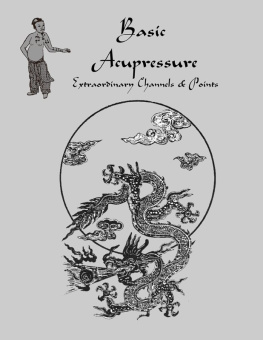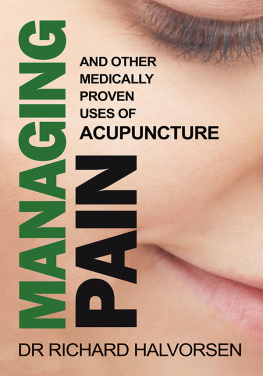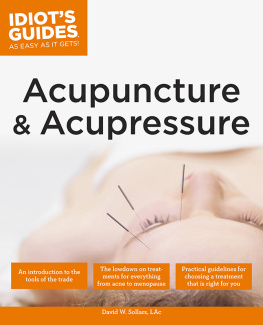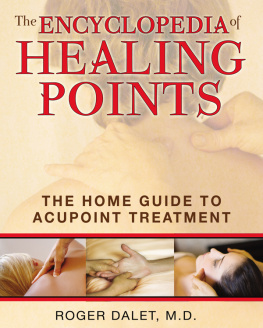Table of Contents
I dedicate this to my lovely and loving wife, Gayle: You deserve thededication in a book of passionate love poems. Unfortunately,my skill as a poet is limited to limericks about men fromNantucket, so Im afraid this will have to do.
ACKNOWLEDGMENTS
I WANT TO THANK MY PATIENTS, who showed their trust in me by letting me be involved with their care and from whom I learned so much. Whatever else I may do, I am first and foremost a healer, and a healers blessings are measured by the gratitude of those he serves. Thanks to you, I have been blessed indeed. I also want to thank my family, my wife, Gayle, and my sons Eric and Bryce, for their understanding over the years I worked on this project. I found out something about myself while writing this book: I am not such a nice guy to be around when I am anguishing over exactly how to word my thoughts on a subject I care deeply about. Those closest to me took the brunt of my moods and put up with me anyway. Gayle also caught many mistakes proofreading, and Bryce corrected many of my grammatical errors.
I want to offer a special thanks to three people who were most responsible for making this book possible. Christel Winkler is a wonderful acquisitions editor who wields a light but spot-on scalpel and who took a chance going to bat for a very rough first-time author. Bert P. Krages is a literary agent who likewise took a chance on me and not only did a wonderful job representing me but also gave me extremely savvy advice early on that undoubtedly helped us find a publisher. Claudia Suzanne is an editor, book doctor, and compassionate cheerleader who literally took a cardboard box full of very rough drafts and somehow forged a workable structure for me to begin putting something readable together. Of course, even with the support of these three, I would not have anything to show for my work if the decision-makers at Penguin did not see something worthwhile in this project, for which I am so very grateful. Donna Ikkanda, Jeanine Henderson, and Ron Brown provided me with fine illustrations, and copy editor Martha Ramsey tightened things up nicely.
Some of my colleagues in the healing arts who gave me invaluable feedback include Dr. Elad Schiff, M.D., Dr. Yoon-Hang Kim, M.D., MPH, Ann Bailey, R.N., M.S., L.Ac., Dipl.Ac., and Corinne Axel-rod, MPH, L.Ac., Dipl.Ac. I attempted to go to the direct sources whenever possible and was fortunate to get help from key people in the following organizations: Dort Bigg, Executive Director of the Accreditation Commission for the Certification of Acupuncture and Oriental Medicine, Debra Presinger, Interim CEO of the National Commission for the Certification of Acupuncture and Oriental Medicine, C. James Dowden, Executive Director, and Zeus Rivera, MIS Associate of the American Academy of Medical Acupuncture, Dr. John Amaro, D.C., FIAMA, Dipl.Ac. (IAMA) (NCCAOM), L.Ac., of the International Academy of Medical Acupuncture, Barbara Esher, AOBTA CL., Dipl. ABT&Ac. (NCCAOM), L.Ac., Director of Education, American Organization for Bodywork Therapies of Asia, Dr. David Field, N.D., L.Ac., former President of the California Naturopathic Doctors Association, and Dr. Sally Lamont, ND., L.Ac., former Executive Director of the California Naturopathic Doctors Association. Thank you all for your time and help. I also wish to extend a special thanks to Dr. Zhang-Hee Cho, of the University of California at Irvine, for his immense contributions to the field of acupuncture research as well as for his friendship.
I could not begin to list all of my patients who offered advice and support over the many years I worked on this while I was working on them. Some, though, deserve special mention: the Ross familyFloyd Senior for his clear thinking and introducing me to the work of Joseph Campbell, Floyd Junior for insights on the subject of physics, and especially Kashi Ross for her pointing out that my early attempts to explain the concept of qi were lacking. Others include Allan Andrews, the late Mildred (Billie) Talley, and Mitzi Hiett. I also want to mention the help of a patient, friend, and pioneer in the field of holistic health care information, Suzan Walter, President of the American Holistic Health Association.
I would need an entire book to acknowledge the gratitude I feel toward my foremost teacher, Hua-Ching Ni, a.k.a. Master Ni. I could not imagine anyone else who brings together so many qualities: brilliant insight, truly transcendental spiritualism, humility, humor, an unmatched work ethic, a unique balance of embodying the essence of the ancient with the practical need to stay current... the list goes on. As highly as I think of this man, I would be doing a disservice to his teachings if I did not acknowledge that he was trained to pass along the insights derived from those who for thousands of years lived as one with nature, and sought to preserve the lessons they learned. The many insights I learned from Master Ni were made possible because of those who carried this knowledge forward for the benefit of all. My gratitude toward my teacher, then, extends to the countless generations of teachers before him.
INTRODUCTION
A BLUE-EYED ACUPUNCTURIST
I STICK NEEDLES IN PEOPLE FOR A living. Its okayIm an acupuncturist, and thats what we do. Considering that most people hate needles, you might think acupuncturists such as myself would have trouble convincing people to let us stick them, but while this may have been the case fifteen or twenty years ago, today the opposite is true. Not only is my practice quite busy but also the ancient Chinese practice of acupuncture is experiencing an explosion of popularity in virtually every corner of the globe. Clearly, a large number of people have come to believe two things: (1) acupuncture works, and (2) it doesnt hurt.
I had come to those two conclusions myself when I took what most of my friends and family thought to be a bad gamble and enrolled in an acupuncture college in the early 1980s. Back then, the future of acupuncture in the United States was not such a sure thing; in fact, most Americans thought the idea was absurd. How could poking needles in people help anything? they would ask.
But those of us who had experienced the effects of acupuncture firsthand knew it worked. Some of us had become fascinated by it and felt a calling to spread the good news to others. Small groups of us found our way to tiny acupuncture schools, many with strange names, and started paying tuition for training in a practice we all knew was a valuable form of treatment, even if we werent sure it would ever earn us a living.
As difficult as it may be for many to believe, acupuncture has the potential to be an effective form of therapy in virtually every area of medicine. In addition to treating pain, acupuncture is useful for such internal conditions as angina, asthma, bronchitis, constipation, diabetes, and hypertension, as well as disorders involving every organ and gland. Acupuncture also treats skin disorders; reproductive disorders, including infertility, impotence, and most female disorders; neurological disorders, including multiple sclerosis, Parkinsons disease, post-stroke complications, and neuropathy; pediatric, geriatric, and psychiatric disorders; and even such modern problems as chemical dependency and chemical sensitivity, as well as AIDS and its associated complications. A well-trained acupuncturist has the potential to treat a wider variety of patients than virtually any other type of health care professional. Knowing this gave many of the first generations of American acupuncturists the confidence we needed to enter this new-to-the-Western-world field. The problem we faced was that we were the









